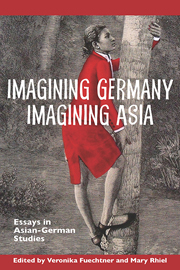Book contents
- Frontmatter
- Contents
- Acknowledgments
- Introduction
- Part I Contemporary Challenges to German Borders and Identities
- Part II Travel and Representation
- Part III Asia Inhabits Germany's Cultural and Intellectual History
- 10 The Tat Tvam Asi Formula and Schopenhauer's “Deductive Leap”
- 11 German Indophilia, Femininity, and Transcultural Symbiosis around 1800
- 12 Reading Genji in German: Reflections on World Literature and Asian-German Studies
- Bibliography
- Notes on the Contributors
- Index
11 - German Indophilia, Femininity, and Transcultural Symbiosis around 1800
from Part III - Asia Inhabits Germany's Cultural and Intellectual History
- Frontmatter
- Contents
- Acknowledgments
- Introduction
- Part I Contemporary Challenges to German Borders and Identities
- Part II Travel and Representation
- Part III Asia Inhabits Germany's Cultural and Intellectual History
- 10 The Tat Tvam Asi Formula and Schopenhauer's “Deductive Leap”
- 11 German Indophilia, Femininity, and Transcultural Symbiosis around 1800
- 12 Reading Genji in German: Reflections on World Literature and Asian-German Studies
- Bibliography
- Notes on the Contributors
- Index
Summary
Performed sixty-eight times in Berlin by 1847 and ninety times in Vienna by 1844, August von Kotzebue's Die Indianer in England portrays an exceptional female character: the Indian girl Gurli. The leading journal of German Enlightenment literary criticism, the Allgemeine deutsche Bibliothek, enthusiastically lauded the masterful portrayal of a child of nature:
An naivseynsollenden Mädchen fehlt es auf unserm Theater freylich nicht; aber wie wenige sind so wahr, so ungekünstelt naiv, wie die Gurli unsers Verf[assers]? Ein echtes Kind der Natur, ohne den Anstand zu beleidigen. Sie verletzt unsre Sitten und Herkommen, aber nur, weil sie es nicht kennt, und immer um einen edlen Trick, um heftige, aber untadelhafte Gefühle zu befriedigen. Sie macht lachen, ohne lächerlich zu werden.
Through Gurli's naiveté and her Indian origin, certain ideas and feelings could be verbalized that otherwise could not be articulated publicly by European dramatic characters. only a figure with such a combination of age, gender, and ethnicity could have achieved this enormous popularity on stage.
Almost at the same time that Kotzebue's drama premiered in 1789, the German world traveler Georg Forster translated the ancient Sanskrit drama Sakuntala from its English translation into German in 1790. Immediately afterward, German intellectuals such as Johann Gottfried Herder and Johann Wolfgang Goethe highly praised Sakuntala's lyrical values and considered it a prominent document of human origin marked by natural purity.
- Type
- Chapter
- Information
- Imagining Germany Imagining AsiaEssays in Asian-German Studies, pp. 204 - 219Publisher: Boydell & BrewerPrint publication year: 2013

